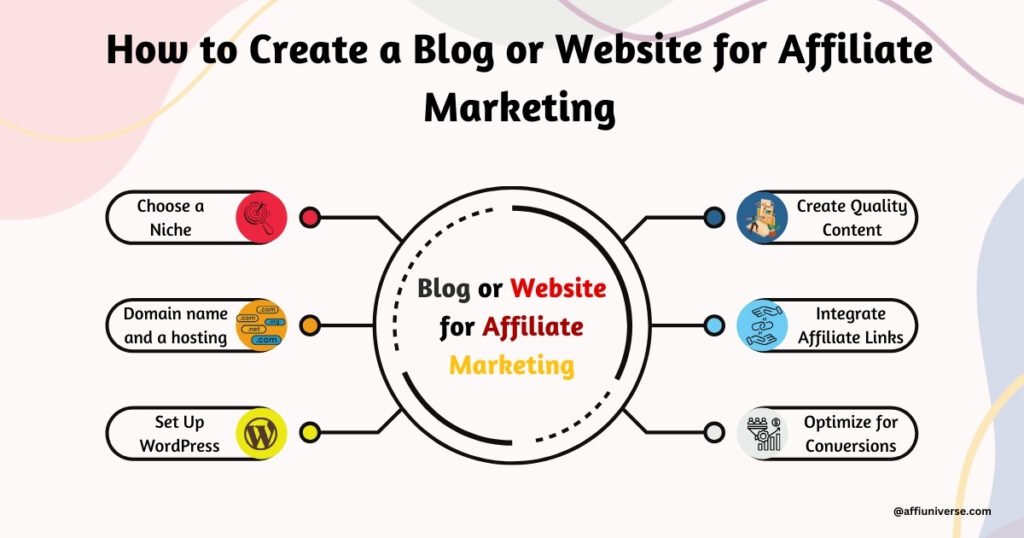Introduction to Affiliate Marketing:

In the ever-evolving world of digital marketing, one strategy has consistently stood out: affiliate marketing. As a form of performance-based marketing, this model creates opportunities for businesses to expand their reach while allowing individuals to generate income by promoting products and services. Today, affiliate marketing has become a lucrative option for marketers at all levels, offering a cost-effective and scalable way to earn money online.
What is Affiliate Marketing?
Affiliate marketing is a business model where affiliates promote products or services on behalf of companies in exchange for a commission. Affiliates use banners, buttons, sponsored links, pop-ups, or other clickable links on their websites, blogs, social media accounts, or other digital platforms. Each time a user clicks on the link and makes a purchase, the affiliate earns a percentage of the sale.
This model benefits both businesses and affiliates:
- For businesses: They gain increased exposure and only pay for actual sales.
- For affiliates: They can generate passive income without the need to create or stock products.
Before diving deeper, let’s understand how affiliate marketing works.
Related Article : 30 Essential AI Tools which Boost Affiliate Marketing
How Does Affiliate Marketing Work?
Affiliate marketing is a performance-based system where affiliates earn commissions by promoting products. It creates a win-win situation for businesses looking to increase sales and individuals seeking passive income.
The affiliate marketing ecosystem involves three key players:
- Merchant (Advertiser) – The company or individual selling a product or service.
- Affiliate (Publisher) – The person or organization promoting the merchant’s products to earn a commission.
- Consumer – The end customer who clicks on the affiliate’s link and makes a purchase.
How Commissions Work
1. Commission
Affiliates earn a commission when they successfully drive sales through their unique tracking links. This commission can be:
- A percentage of the sale (e.g., 10% of the product price).
- A fixed amount per sale (e.g., $5 for every product sold).
The commission structure varies depending on the merchant’s affiliate program. Some programs also offer recurring commissions for subscription-based products.
2. Sign Up
To start earning, affiliates need to join a merchant’s affiliate program. This involves:
- Registering on the merchant’s website.
- Receiving a unique tracking link that monitors referrals and sales.
- Agreeing to the program’s terms and commission structure.
3. Promote
Once they have their affiliate link, affiliates promote the merchant’s products through different channels, such as:
- Blogs & Websites – Writing reviews, product comparisons, or guides.
- Social Media – Sharing links on platforms like Facebook, Instagram, or TikTok.
- Email Marketing – Sending promotions to their subscriber list.
4. Click
Consumers are redirected to the merchant’s website when they click the affiliate link. The tracking system records the click and associates it with the affiliate.
5. Purchase
If the consumer purchases, the sale is tracked using cookies or other tracking technology. Once confirmed, the affiliate earns a commission based on the program’s terms.
This process makes affiliate marketing a win-win strategy: merchants gain more sales, and affiliates earn passive income by promoting relevant products.
Types of Affiliate Marketing :
Affiliate marketing offers various strategies for promoting products, allowing affiliates to choose methods that best suit their audience. Whether through engaging content, exclusive discounts, targeted emails, or social media influence, each approach helps drive sales and maximize earnings while providing value to consumers in different ways.

- Content Marketing: Affiliates directly insert themselves in the content of vlogs, blogs, review videos, how-to videos and others, that contain or are linked to the product.
- Coupon Sites: Affiliates make use of coupons and bargains for a group of consumers ready to retire with a bargain.
- Email Marketing: The following are the benefits of using email newsletters: The affiliates send the newsletters to interested subscribers and use them to advertise products directly.
- Social Media: This way Affiliates garner a wider audience by acting through visually appealing platforms such as Instagram, YouTube, and TikTok.
Benefits of Affiliate Marketing :
Affiliate marketing offers a low-risk, high-reward opportunity for individuals looking to earn online. With minimal startup costs, the potential for passive income, and the freedom to work from anywhere, affiliates can create flexible income streams. Performance-based rewards ensure earnings are tied to results, making it an efficient and scalable business model.
- Low Startup Cost: It may require little or no capital to initiate an affiliate marketing business compared to other business models.
- Passive Income: As stated, affiliate links may earn constant income since the affiliate marketer only establishes the links initially.
- Flexibility: Affiliates can set up working from home and pick products they want to advertise from a variety offered.
- Performance-Based Rewards: There are pay-per-sale and pay-per-click plans where affiliates are paid according to the outcome of the campaign, motivating them to source quality traffic.
Setting Up Your Affiliate Marketing Platform
Affiliate marketing is a profitable way to earn money by promoting products from other companies. To succeed, it’s essential to build a strong platform that connects with your target audience. This involves creating a blog or website, growing an email list, and leveraging social media for marketing.

1. Choose a Niche
Selecting a specific niche helps you focus on a targeted audience. Choose a subject that aligns with your expertise and has demand within your market. A well-defined niche makes it easier to create relevant content and attract the right consumers.
2. Join Affiliate Programs
Sign up for reputable affiliate programs that offer products relevant to your niche. Platforms like Amazon Associates, ShareASale, and CJ Affiliate provide various opportunities to earn commissions. Choosing the right program ensures you promote products that resonate with your audience.
3. Create Quality Content
Content is the backbone of affiliate marketing. Develop engaging and informative blogs, product reviews, or video content that naturally incorporates your affiliate links. The more valuable your content, the more likely your audience will trust and follow your recommendations.
4. Build an Audience
Growing your audience requires effective promotion. Utilize SEO techniques to rank on search engines, engage with followers on social media, and use email marketing to nurture leads. The broader your reach, the higher your chances of driving conversions.
5. Analyze and Optimize
Track the performance of your affiliate campaigns using analytics tools. Regularly analyze traffic, click-through rates, and conversion rates to refine your strategies. Optimizing your approach helps maximize earnings and improve audience engagement.
Overcoming Common Challenges
- Competition – Stand out by offering unique insights, expert advice, and high-quality content that adds value beyond generic promotions.
- Trust Issues – Build credibility by promoting only products you genuinely believe in and providing honest, transparent reviews.
- Traffic Generation – Invest time in SEO, social media engagement, and content marketing to attract more visitors to your platform.
By following these steps, you can create a strong foundation for a successful affiliate marketing business while overcoming common obstacles along the way.
How to Create a Blog or Website for Affiliate Marketing

1. Choose a Niche
Choosing your area of specialization is the first step toward pursuing affiliate marketing. Your niche must be something that you are interested in and has a market that can generate good returns. To do effective research, obtain prospects, and discover that there are products you can promote, you should research potential niches.
2. Choose your domain name and a hosting platform.
Make sure the domain is closely related to your niche and try to pick one that people would remember. Engage the services of a good and reputable host to be able to run the site in the most efficient manner. Some of the most trending Web Hosts are BlueHost, SiteHost, and HostGator.
3. Set Up WordPress
WordPress rules this niche because it is versatile and straightforward to use when constructing affiliate marketing sites. To do that, activate your hosting account and install the WordPress platform, then, select an attractive and flexible template.
4. Create Quality Content
It has been argued that content is the key when it comes to affiliate marketing. Create articles that would be informative to your readers like dealing with product reviewing, tutorials, and suggestions on topics relevant to your area of supposed expertise. Make it SEO-first to ensure that you will be accessed naturally by people using the search engines.
5. Integrate Affiliate Links
Approach affiliate marketing programs relevant to your specialized area of interest, which include Amazon associates, Sharesale or Commission junction. Encourage the use of refined affiliate links that are likely to blend with the content you are creating. Always disclose your affiliation to your audiences so that there is no dubiosity when giving your opinions.
6. Optimize for Conversions
Some of the areas include analyzing your traffic using mechanisms such as Google Analytics in order to understand how to better position yourself for closed deals. Experiment with CTA buttons, configurations, and affiliate link placements to find the optimal one which works best .
Building an Effective Email List for Affiliate Marketing
An email list is a crucial asset for affiliate marketers, allowing direct communication with potential customers. A well-structured email strategy helps nurture leads, build trust, and drive affiliate sales. Here’s how to create and maintain a successful email list:

1. Choose the Right Email Marketing Platform
Selecting a reliable email service provider is essential for managing your list and automating campaigns. Platforms like Mailchimp, ConvertKit, and AWeber offer tools for segmentation, automation, and performance tracking to streamline your email marketing efforts.
2. Create a Compelling Lead Magnet
Offer an incentive in exchange for email sign-ups. This could be an exclusive guide, a discount, a free course, or any valuable resource relevant to your niche. The lead magnet should be enticing enough to encourage users to subscribe.
3. Design High-Converting Opt-In Forms
Strategically place opt-in forms on your website, including pop-ups, slide-ins, and inline forms within blog posts. Ensure they are visually appealing and easy to complete to maximize conversions.
4. Develop an Engaging Welcome Series
A well-crafted welcome email sequence introduces subscribers to your brand, sets expectations, and provides immediate value. Use this series to share helpful insights, build rapport, and subtly introduce affiliate products.
5. Segment Your Email List
Organizing subscribers based on interests, behaviors, or engagement levels allows for personalized communication. Segmentation ensures that subscribers receive content relevant to their needs, increasing engagement and conversion rates.
6. Send Value-Driven Emails Consistently
Maintain regular contact with your subscribers by sharing useful tips, industry insights, and exclusive offers. Balance promotional content with valuable information to build trust and keep your audience engaged without overwhelming them with sales pitches.
By following these steps, you can create a high-performing email list that drives conversions and strengthens your affiliate marketing strategy.
Social Media Marketing and Its Role in Affiliate Marketing
Social media has become a powerful tool for affiliate marketers, allowing them to reach a vast audience, engage with potential buyers, and drive sales. Platforms like Instagram, YouTube, Facebook, and TikTok enable affiliates to promote products through engaging content, build trust with followers, and increase conversions using targeted strategies and authentic recommendations.

1. Choose the Right Platforms
Determine which social networks you and your target audience frequently tend to use. Instead of trying to be active on all platforms, choose the most relevant ones; Facebook, Instagram and Twitter, as well as Pinterest.
2. Create a Content Calendar
Manage your social media content through the use of a content calendar where you pre-design your content for the season. It is advised to post at a regular interval because online users usually drop by at recurrent times. Post occasional advertisements, enrich with attractive questions, give useful tips, and sometimes share less-known information about your work.
3. Share Quality Content
Expand on the content that your viewers find relevant and share it. One way of making your posts more appealing is through the use of images, short videos or even infographics. Thus, ensure your posts are going to add some value and can spur your customers into a conversation.
4. Use Affiliate Links Wisely
When appropriate, use affiliate links as part of the messages that you post on the social media. Instagram users can provide links to the content that they promote in the bio or in the stories; Pinterest, in turn, allows you to pin items with affiliate links. It is important to always declare affiliation in order to ensure this year and avoid misleading people.
5. Engage with Your Audience
It will help if you actively participate in commenting, answering questions, and providing your opinion on the posts. When you are able to foster a community for your brand, this will lead to more trust and people will tend to follow your links or click on your affiliate links.
6. Analyze and Adjust
With the social media platforms, one can be able to get analytics for the content he posts through the/pages he manages. Look at the kind of content that has high engagement and conversion rates and design your strategy around such content. Finally, never to cease experimenting with different approaches in order to enhance the results that you get.
When this is done systematically through having appropriate blog or website, streamlined email list, and a proper use of social media, then one is able to develop a strong platform for affiliate marketing. Always bear it in mind that long term success in online marketing is more dependent on consistency and more importantly on the value – the ability to bring value to the target audience. Happy marketing!
FAQ :-
What is Affiliate Marketing ?
Affiliate marketing may refer to a business model whereby affiliates help to sell the products and services of other companies with an agreement that they will receive a percentage of the sales. They use banners, buttons, sponsored links, pop-ups, or any other clickable link to the given products, on their website, blog, social media account, or any other portal. These are hyperlinks, place by the affiliate on his own site; each time a user clicks on the link and buys a product, the affiliate gets a cut from the sale.
What are the Benefits of Affiliate Marketing ?
1.Low Startup Cost : It may require little or no capital to initiate an affiliate marketing business compared to other business models.
2.Passive Income : As stated, affiliate links may earn constant income since the affiliate marketer only establishes the links initially.
3.Flexibility : Affiliates can set up working from home and pick products they want to advertise from a variety offered.
4.Performance-Based Rewards : There are pay per sale and pay per click plans where affiliates are paid according to the outcome of the campaign, motivating them to source quality traffic.
How to Create a Blog or Website for Affiliate Marketing ?
1. Choose a Niche.
2. Choose your domain name and a hosting platform.
3. Set Up WordPress.
4. Create Quality Content.
5. Integrate Affiliate Links.
6. Optimize for Conversions.
How can I Create an email list ?
1. Select an Effective Email Marketing Service.
2. Create a Lead Magnet.
3. Design an Opt-In Form.
4. Develop a Welcome Series.
5. Segment Your List.
6. Regularly Send Value-Driven Emails.
How can I make a Quality Content ?
Expand on the content that your viewers find relevant and share it. One way of making your posts more appealing is through the use of images, short videos or even infographics. Thus, ensure your posts are going to add some value and can spur your customers into a conversation.
How do I Set Up my Affiliate Marketing Platform ?
1. Create a Blog or Website for Affiliate Marketing.
2. Construct an email list.
3. Use Social Media Marketing Tools.





